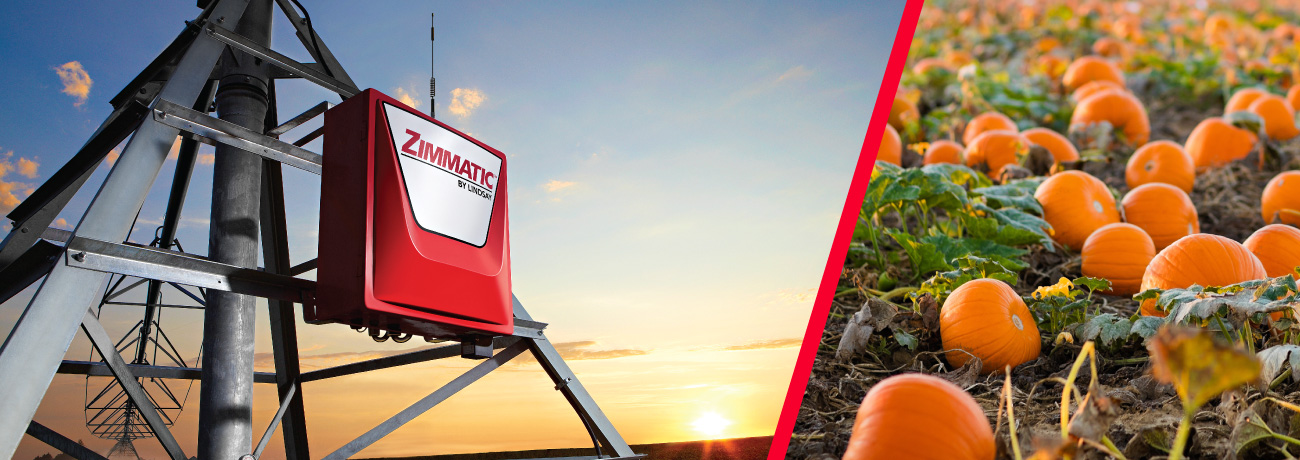Zimmatic Blog
7 Things to Know About Growing Fall’s Favorite Specialty Crop
Oct 6, 2022

When you think of Fall, it’s hard not to think about pumpkins. Jack-o-lanterns on front porches. Decorative gourds on dining room tables. Pumpkin pie with a dollop of whipped cream. They’ve become a quintessential part of the season for many of us.
In fact, according to the U.S. Department of Agriculture, over 1 billion pounds of pumpkins are grown every year in the United States alone—with Illinois being the biggest producer.
So, to celebrate the gourd season, we’ve rounded up the top things to know about growing Fall’s favorite specialty crop.
1) Water is critical for pumpkin production
It’s no secret that water is a critical component of growing all crops. But the precise amount of water that a crop needs varies based on factors like the type of crop and growing environment.
When it comes to pumpkins, these specialty crops consist of over 90 percent water and require just the right amount of irrigation to thrive. Too little water during the planting and growing stages could delay development or cause gaps in production. Too much water could starve the roots of oxygen. Finding the right balance helps avoid water stress that could result in small, misshapen pumpkins or reduced yield.
There are several types of irrigation systems that farmers can successfully leverage to ensure proper water management and delivery. The final decision ultimately depends on factors like land, labor availability, water supply and/or investment.
2) Sprinkler systems like pivot irrigation are ideal
Many of today’s pumpkin producers irrigate with some type of sprinkler irrigation system, such as center pivot or lateral-move irrigation systems.
The benefit of pivot irrigation is the uniformity and precise application of water and fertilizer. Not only does this boost efficiency and conserve resources, but it provides optimal nutrients and irrigation to maximize yields.
And those yields could include growing prized pumpkins like the 1000-pound pumpkin Jim Seamons from Utah grew using a Zimmatic™ center pivot. While that giant may have been his largest pumpkin prize to date, he’s also reaping the rewards of pumpkins diversifying his operation and making it more sustainable. You can read more about his story here.
3) Pumpkins have a large root system
While pumpkins may grow above ground on flowering vines, they actually have quite an extensive root system below ground. According to the University of Georgia, these roots can penetrate up to several feet into the soil.
While the rooting depths vary based on soil conditions or operation practices, there is typically an upper root system and a taproot system, which branches out and goes deeper.
This root system works to collect moisture, air and nutrients as the crop grows. Since we can’t see below ground, precision irrigation solutions and technologies help ensure optimal irrigation and soil moisture levels.
4) Water early in the day
When it comes to irrigation schedules for pumpkin crops, watering earlier in the day is best. This allows for any excess water to run or dry off during the day, instead of leaving soil and pumpkin leaves damp overnight.
If you’re concerned about under watering, one tip is to keep an eye on the pumpkin leaves. While they may wilt during the day, especially during the hottest parts, they should bounce back by evening. If they are still wilted once temps cool off, it may be a sign that the crops aren’t getting enough water.
5) Soil moisture monitoring can prevent crop stress
Your soil can tell you a lot about what’s going on with your crop and what’s needed when it comes to irrigating efficiently and maximizing yields.
There are a few things you can do to first understand and evaluate your soil health before planting, such as looking at data or testing nutrient contents. However, soil moisture monitoring is key throughout the crop cycle to tailor your irrigation plans to the specific needs of your crops or fields.
Solutions like FieldNET Advisor™ can help simplify monitoring and irrigation management by providing insights and recommendations based on the crop type. It tracks crop growth and root depth to monitor soil moisture, keeps tabs on daily crop water usage, forecasts soil water depletion and more. That way, you can make more informed decisions when it comes to irrigating your pumpkins.
6) Feed pumpkins just enough N&K
Fertilizer can supply the soil and crops with valuable nutrients to promote growth. But it’s important to remember that a little goes a long way. For happy pumpkins, you want to offer just enough nitrogen and potassium.
Not sure what “just enough” means? Sometimes it may mean applying a moderate amount and then waiting before adding more. Solutions like VRI technology, with the help of FieldNET™, allow you to apply exactly the right amount of chemicals (and water) to specific areas of your field.
7) Rotate with wheat, rye or small grain crops
If you’re looking to diversify your operation or add pumpkins to your crop rotation, here’s a few things to keep in mind. As part of the gourd or cucurbits family, pumpkins can help with soil health, weed reduction or plant disease control.
You’ll commonly see pumpkins on a three-year crop rotation with small grain crops like wheat, rye or oats. We’ve also seen success with crops like sweet corn, alfalfa and legumes. It all depends on what works best for you, your operation and your crops.
Want to learn more about how precision irrigation can help boost pumpkin production? Reach out to your local Zimmatic dealer today!